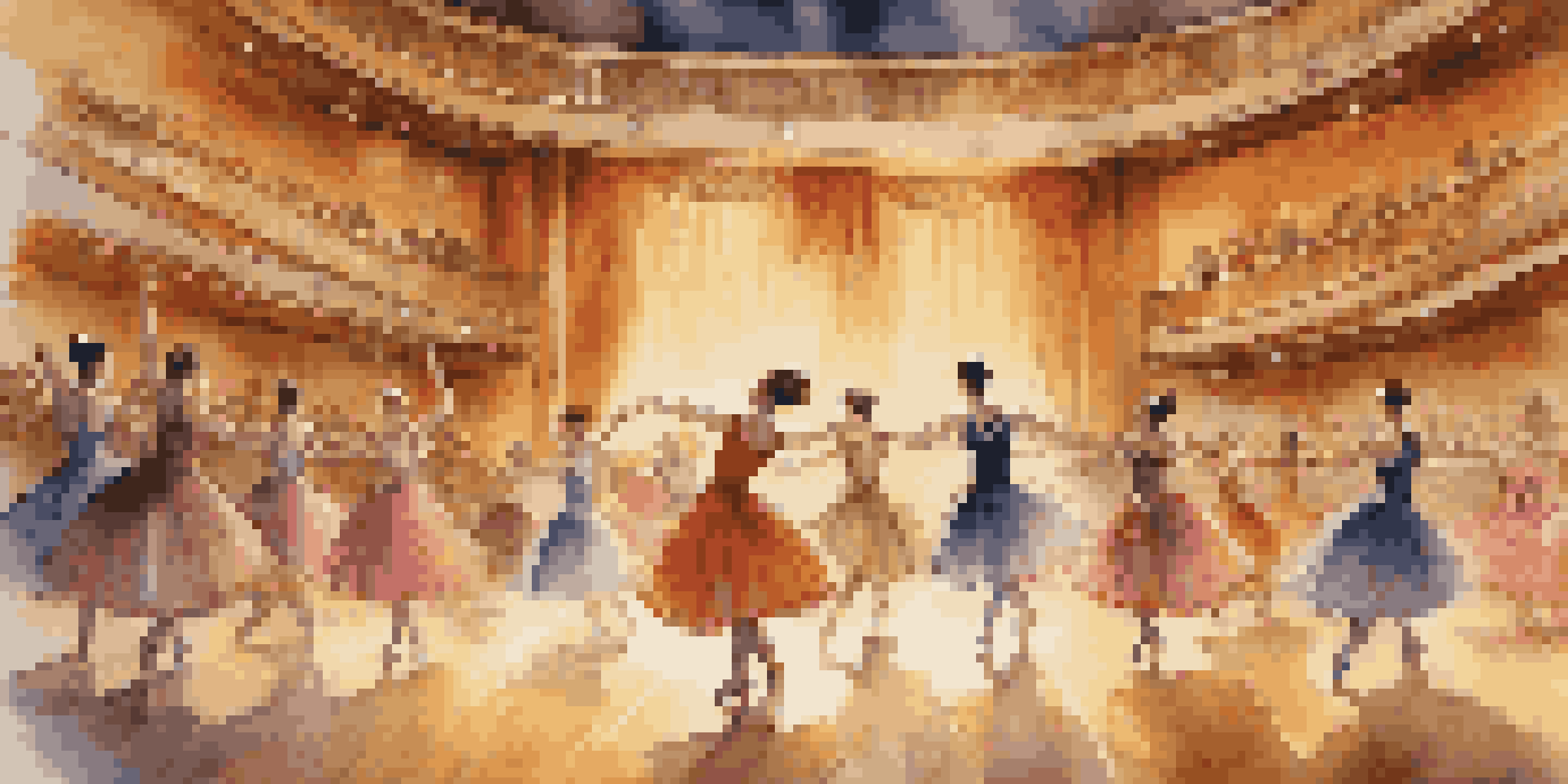Audience Reception: How Critics Shape Dance Experiences

Understanding Audience Reception in Dance
Audience reception refers to how viewers interpret and respond to a dance performance. It encompasses emotions, thoughts, and overall engagement, shaping the experience of both the audience and the artists. The reception can vary widely based on individual backgrounds, prior knowledge of dance, and personal tastes, making it a fascinating area of study.
Dance is the hidden language of the soul.
When audiences walk into a theater, they bring their own expectations and experiences with them. For instance, someone who has studied ballet may view a contemporary piece differently than a casual observer. This diversity in interpretation highlights the importance of context and individual perspective in appreciating dance.
Critics play a pivotal role in this dynamic, often acting as a bridge between the performance and the audience. Their reviews can influence public perception, setting the stage for how a piece will be received long after the curtain falls.
The Role of Dance Critics in Shaping Perspectives
Dance critics are often seen as gatekeepers of the art form, providing insights and evaluations that can enhance or diminish a performance's reputation. Their reviews can frame the conversation around a piece, highlighting strengths or weaknesses that audiences may not have considered. This influence can be particularly powerful for emerging artists seeking recognition.

For example, a rave review from a respected critic can propel a lesser-known choreographer into the spotlight, attracting larger audiences and potential funding. Conversely, a negative review can lead to misunderstandings about a performance's intentions or merit, affecting ticket sales and future opportunities for the artists involved.
Audience Reception Shapes Experience
Audience reception is influenced by individual backgrounds and expectations, significantly impacting how performances are interpreted and enjoyed.
Critics also help to contextualize dance within broader cultural conversations. By drawing connections to social issues, historical contexts, or artistic movements, they enrich the audience's understanding and appreciation of the work, encouraging deeper engagement.
The Impact of Social Media on Dance Criticism
In today's digital age, social media has transformed the landscape of dance criticism. Platforms like Twitter, Instagram, and TikTok allow audiences and critics alike to share their thoughts in real-time, creating a more immediate dialogue around performances. This can democratize criticism, giving a voice to everyday viewers alongside professional reviewers.
Art is not freedom from discipline, but disciplined freedom.
However, this shift also presents challenges. With the rise of 'influencers' and casual commentators, the quality and depth of critique can vary significantly. Some posts may prioritize sensationalism over thoughtful analysis, potentially skewing audience perceptions based on trends rather than artistic merit.
Despite these challenges, social media can enhance the dance experience by fostering community discussions and facilitating connections between artists and audiences. This interactivity can lead to a richer understanding of the art form, as viewers engage with diverse perspectives and insights.
How Audience Expectations Influence Reception
Audience expectations play a crucial role in shaping how a dance performance is received. These expectations can be influenced by various factors, including marketing materials, previous experiences, and even the reputation of the artists involved. When expectations align with the performance, audiences are likely to have a more enjoyable experience.
For instance, a highly anticipated show from a renowned choreographer may lead audiences to expect groundbreaking choreography and emotional depth. If the performance meets these expectations, it can lead to a positive reception. However, if it falls short, disappointment can overshadow the audience's experience.
Critics Influence Dance Perception
Dance critics serve as key intermediaries, shaping public perception and understanding through their reviews and contextual insights.
Understanding this interplay between expectation and reception can help choreographers and companies make informed creative decisions. By managing audience expectations through effective communication, they can create a more satisfying experience for everyone involved.
Cultural Context and Its Effect on Dance Reception
Cultural context is another significant factor in audience reception. Dance is a reflection of cultural norms, values, and histories, which means that performances can resonate differently across various communities. For example, a dance piece rooted in a specific cultural tradition may be received with enthusiasm by those familiar with that context, while it might confuse or alienate others.
This disparity highlights the importance of cultural representation in dance. When artists draw on their cultural backgrounds, they not only enrich the art form but also provide audiences with opportunities for education and connection. Critics who understand and appreciate this context can offer valuable insights that enhance audience reception.
Moreover, understanding cultural context can lead to more inclusive conversations about dance. By recognizing the diverse backgrounds of both artists and audiences, critics can champion a broader spectrum of dance forms, fostering appreciation and understanding across cultural divides.
The Emotional Connection Between Dance and Audience
Dance has a unique ability to evoke emotions, creating a powerful connection between performers and audiences. This emotional resonance can be influenced by both the choreography and the audience's personal experiences. When a performance strikes a chord, it can lead to a profound appreciation that transcends the technical aspects of the dance.
For instance, a piece that explores themes of love, loss, or resilience may resonate deeply with viewers who have faced similar experiences. Critics who articulate these emotional connections can help audiences appreciate the depth of a performance, encouraging them to reflect on their own feelings and experiences.
Cultural Context Enhances Engagement
Cultural context plays a vital role in how dance is received, highlighting the importance of representation and understanding in fostering appreciation.
By fostering these emotional connections, dance can serve as a catalyst for dialogue and understanding. Critics who highlight the emotional undercurrents of a performance can enhance audience engagement, making the experience more memorable and impactful.
The Future of Audience Reception in Dance
As the dance landscape continues to evolve, so too will audience reception. The rise of virtual performances, interactive experiences, and cross-genre collaborations offers new possibilities for how audiences engage with dance. This shift could lead to more diverse interpretations and a broader appreciation of the art form.
Additionally, as critics adapt to these changes, they will play a crucial role in shaping audience perceptions. By embracing new platforms and forms of expression, critics can connect with audiences in innovative ways, fostering a deeper understanding and appreciation of dance.

Ultimately, the future of audience reception in dance will depend on collaboration between artists, critics, and audiences. By engaging in open dialogues and embracing diverse perspectives, we can create a richer, more inclusive dance experience for everyone.